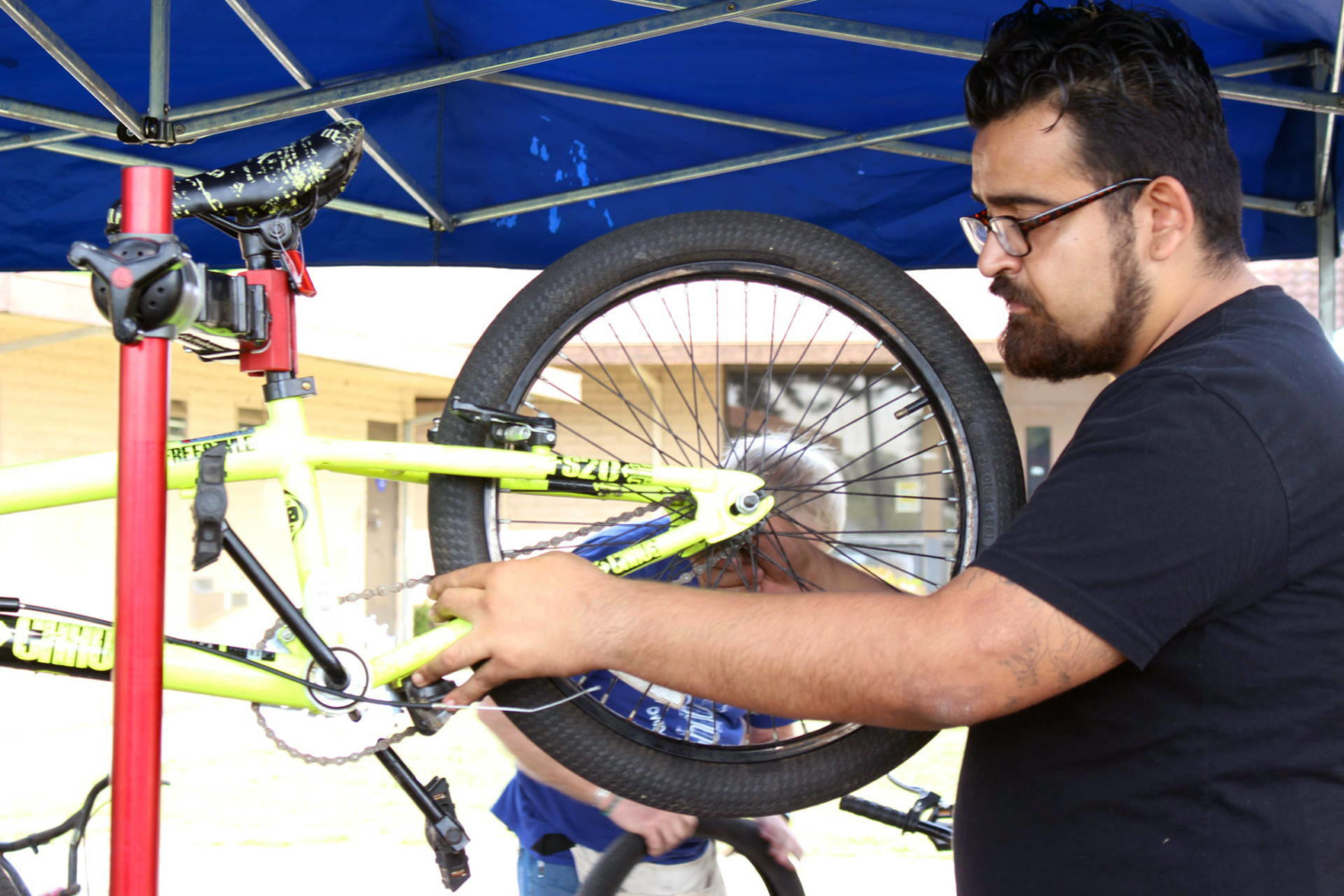
In the News
How Fresno Man Started Biking and Reversed Type 2 Diabetes
-
Focus Areas
Chronic Disease Prevention, Healthy Communities -
Issues
Physical Activity -
Programs
Cultiva La Salud/Central California Regional Obesity Prevention Program

FRESNO — Jaime Rangel holds a bike tire and begins checking with his hands for thorns and other sharp objects that might be puncturing the tire’s rubber tread. His fingers, stained with black patches of oil, move quickly and seamlessly. He’s done this type of work dozens of times before.
All around him, a steady stream of kids line up to get their bikes’ flat tires and faulty brakes fixed at this free event at a park in southeast Fresno.
The free bike repairs are a preamble to the Cumbia Ride, a group bike ride with Latin American dance music started last year by Fresno’s Cultiva la Salud to promote biking and a healthier lifestyle among Latino families.
Rangel, 26, says he’s here fixing bikes because he relates to many of the young riders at the event — kids who can’t afford to have their bikes repaired.
“When I was a kid, no one showed me how to fix a bike,” he says. “My mom never took me to a bike shop because we grew up low income, so everything I had to learn from scratch.”
Rangel makes a point of showing those skills to the kids and parents lingering by their bikes. He wants young people and adults, especially in working-class neighborhoods like southeast Fresno, to be able to bike more to fend off chronic illnesses such as diabetes.
Rangel speaks from personal experience.
Facing Type 2 Diabetes as a Teen
Rangel was just 14 and living with his family in Los Angeles when he was diagnosed with Type 2 diabetes. Obesity and a sedentary lifestyle are risk factors for the illness. While he was tall — 6-foot-1 — he weighed 260 pounds.
It’s been a dozen years since he was diagnosed, but he clearly recalls how frightened he was. The disease had already transformed the lives of his mother, two sets of grandparents and other relatives. He knew what he was facing.
“I was really scared,” says Rangel. “I was seeing there were only certain foods they would eat, taking their insulin shots. And I was like, ‘Nah, that can’t happen. I’m too young!’”
Until about two decades ago, Type 2 diabetes in children and teens was practically unheard of. But the number of adolescents living with the disease has gone up in recent years, in large part because of the obesity epidemic.
As with adults, rates of Type 2 diabetes are higher among Hispanic, African-American and Asian-Pacific Islander youth than non-Hispanic whites, according to data from the Centers for Disease Control and Prevention. Uncontrolled diabetes can lead to blindness, heart disease, amputations, kidney failure and other serious complications.
Rangel’s doctor had said he needed to lose weight and give up foods he loved. But he didn’t know how to start. He loved the idea of biking, but his family couldn’t afford to buy him one.
Instead, a close friend stepped in with a gift of a BMX bike. He didn’t know how to ride and at first it was scary. He fell a lot the first couple of times he tried.
“I was a big dude riding a really small bike, so I didn’t know how to balance my weight,” Rangel says. “But I just kept going. I didn’t want to stop, and I just kept doing it so I could get better.”
With each trip he took, he ventured longer distances. Rangel says he enjoyed the independence he felt while crossing large swaths of the traffic-jammed city. Under the power of his own legs pushing down on his bike’s pedals, he would travel from his home in the Lincoln Heights neighborhood to the beach at Santa Monica — 20 miles away.
Within a year, Rangel had reversed his Type 2 diabetes. His blood sugar levels returned to a normal range. It’s surprising to many, but children and young adults can beat the disease through exercise, say medical experts.
The experience marked Rangel deeply. He had managed to rid himself of the illness without taking medication while having fun, too.
“Biking changed my life. I lost a lot of weight,” says Rangel, who now weighs about 220 pounds.
Rangel’s family noticed the change in the way he looked and the dramatic improvement in his health. At Rangel’s insistence, his mom, cousins and uncles began biking — a dramatic change for his family, he says.
“We all got rid of our diabetes, pretty much,” says Rangel, who recently moved to Fresno. “Now when I’m in L.A., about 20 of us go bike riding together. So it changed not just me, but my whole family at the same time.”
Originally published by KQED
More Updates
Work With Us
You change the world. We do the rest. Explore fiscal sponsorship at PHI.
Support Us
Together, we can accelerate our response to public health’s most critical issues.
Find Employment
Begin your career at the Public Health Institute.



